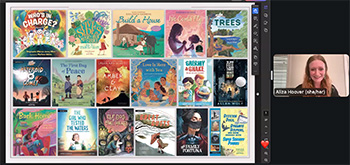Aliza R. Hoover is an agent at the CAT Agency, representing illustrators and author-illustrators in children's books. She began her Publishing career at Candlewick Press, where she spearheaded & coordinated illustrator searches and negotiated illustrator contracts. With a degree in Classics and a background in visual art, she is passionate about the magical place where words and images collide.
Aliza grew up homeschooled and barefoot in the woods, and has lived in Finland and Scotland before returning to her home state of Massachusetts where she lives with her familiar (a cat) and her partner (a human). Outside of books, Aliza is a multimedia photographer, tarot enthusiast, and amateur circus performer.
Aliza says a lot of what she has learned about portfolio curation comes from her experience working at Candlewick Press.
There's no one way to curate a portfolio, says Aliza.
Aliza says she was a book match-maker at Candlewick. Here are some of the books she worked on at Candlewick:
Example of how Aliza found an illustrator for Build A House:
Aliza was looking for an illustrator for a book that came to her in a song.
She looked for a digital illustrator because it would speed up the process, an artist who had a connection with Juneteenth, with poetic sensibilities since it is so lyrical.
Aliza reached out to art directors and designers on the team to see who they've worked with in the past, and also reached out to other agents at the agency. Christy Ewers responded quickly with a great suggestion:
- Interior scenes.
- Inter-generational scenes.
- Fun infographics could set yourself up for nonfiction.
- Think about the kind of work you want to get and include that type of work in your portfolio.
- In your bio, include any info that reflects a niche interest or background that might help you get specific type of work (e.g. biologist, etc.)
- Make a list of things you like to draw.
- Aim for consistency across each style, especially in characters.
- Be aware that some editors and art directors have strong negative feelings about dot eyes, cartoon/Disney-type eyes, and closed eyes.
- Remember that characters are actors, not models. Have them interacting.
- Don't draw what you think people want. Make the art that tells YOUR story.






No comments:
Post a Comment